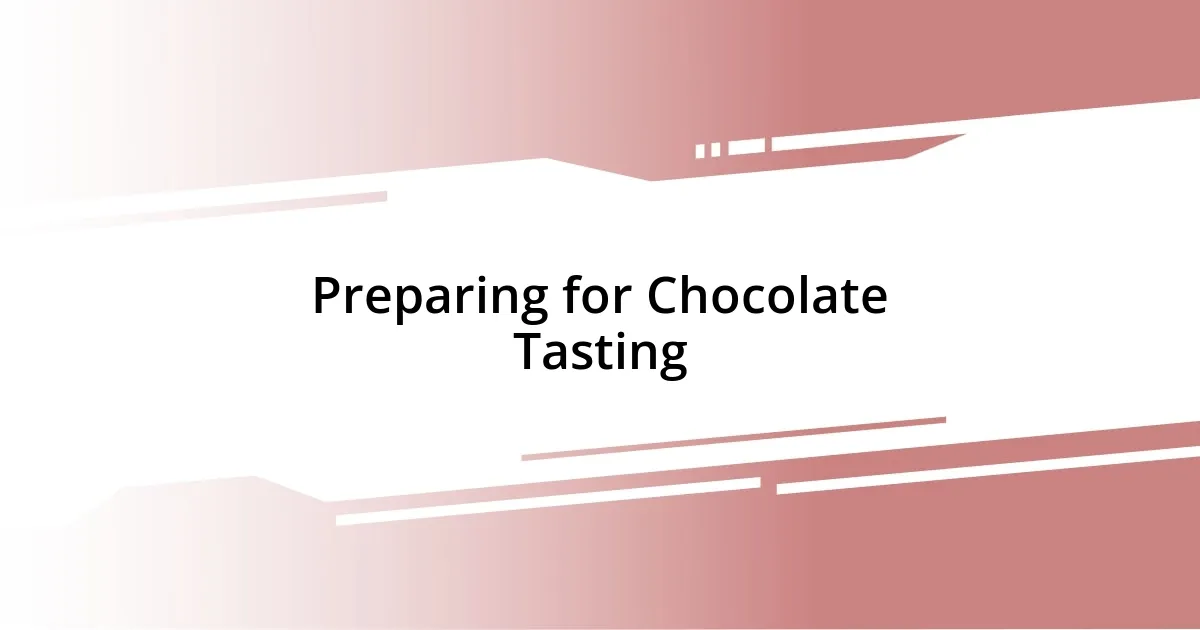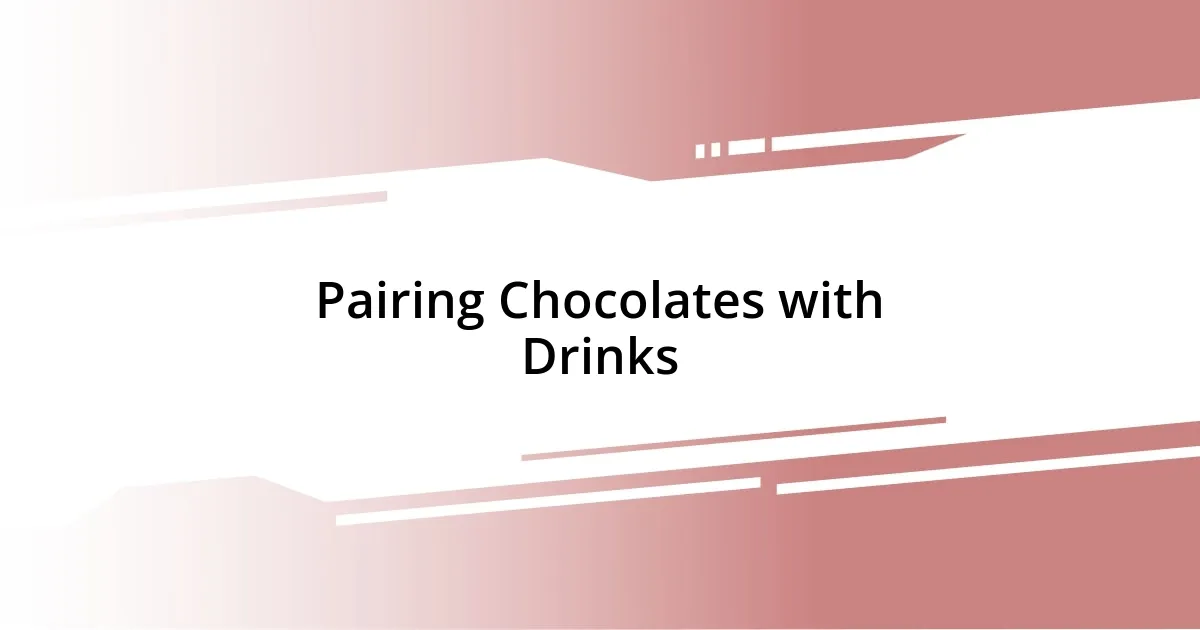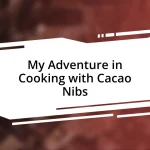Key takeaways:
- Creating an inviting atmosphere, cleansing your palate, and taking notes enhances the chocolate tasting experience.
- Key factors in selecting gourmet chocolates include cocoa percentage, origin, ingredient quality, and ethical sourcing.
- Mindful tasting techniques and experimenting with drink pairings can elevate the appreciation of chocolate flavors.
- Sharing chocolate experiences with friends fosters deeper connections and collective enjoyment of flavors.

Preparing for Chocolate Tasting
Preparing for a chocolate tasting is more than just gathering treats; it’s about setting the right atmosphere. I remember my first proper tasting, where I dimmed the lights and lit a few scented candles, creating an inviting ambiance that made every bite feel special. What little details can you add to elevate your experience?
Before diving into those exquisite chocolates, it’s essential to cleanse your palate. Water is your best friend here, but I’ve found that unsalted crackers do wonders too. They helped me reset my taste buds, allowing me to truly appreciate the unique notes of each chocolate I sampled.
Lastly, don’t forget to take notes during your tasting. The first time I tasted multiple chocolates without writing anything down, I later struggled to recall which one I loved the most. Have you ever forgotten a flavor that captivated you? Trust me, jotting down your impressions can enhance your experience and keep those delightful memories vivid.

Selecting Gourmet Chocolates
Selecting the right gourmet chocolates can feel like a delightful treasure hunt. I remember the excitement of my first visit to a specialty chocolate shop, where the shelves were lined with an array of tantalizing options. As I carefully examined each label, I learned that understanding the origin and cocoa content can significantly influence flavor profiles. For instance, chocolates from different regions can carry distinctive notes, much like fine wines.
As you embark on your selection journey, consider these key points:
-
Cocoa Percentage: Higher cocoa percentages typically offer a richer, more intense flavor. I felt this firsthand when I tried a 70% dark chocolate and was surprised by its deep, complex taste.
-
Origin: Chocolates sourced from specific countries like Madagascar or Ecuador often have unique flavor characteristics. I once tasted an Ecuadorian chocolate that reminded me of fruity notes and floral undertones.
-
Ingredients: Look for high-quality ingredients—think pure vanilla or natural sweeteners, which significantly enhance the chocolate’s flavor. I’ve often found myself captivated by chocolates that proudly list their ingredients, ensuring a pure tasting experience.
-
Ethical Sourcing: Supporting brands that practice fair trade or sustainable sourcing really enriched my appreciation for the chocolate. Knowing that my indulgence helped farmers was an emotional connection I didn’t expect.
These considerations not only deepen your experience but also lead you to discoveries that mirror your palate’s preferences.

Setting Up the Tasting Environment
Setting up the tasting environment is crucial in ensuring an unforgettable experience. On my last chocolate-tasting adventure, I chose my kitchen table as the setting, allowing the delightful aromas to mingle with the surrounding scents of freshly brewed coffee—creating a sensory overload that heightened the tasting. Remember to keep the space well-lit but not harsh; a soft glow truly complements the allure of gourmet chocolates.
Another aspect I’ve learned is to minimize distractions. I usually silence my phone and play soft background music, which sets a relaxing tone. The perfect playlist might just be as important as the chocolate itself! It surprises me how much it adds to my enjoyment, allowing me to fully immerse myself in each tantalizing bite.
Lastly, arrange the chocolates thoughtfully. I’ve experimented with different layouts—sometimes in a circle, other times in a line, but I’ve found that a clean, organized display enhances the overall experience. Ensuring each chocolate has its own space allows me to appreciate its unique packaging and presentation, giving me more context as I savor each piece.
| Aspect | Details |
|---|---|
| Lighting | Soft, inviting glow enhances ambiance |
| Distractions | Maintain focus with minimal interruptions |
| Arrangement | Organized layout elevates presentation |

Techniques for Taste Testing
Engaging in a gourmet chocolate taste test involves more than just biting into a piece; it’s about savoring every moment. One technique I find incredibly rewarding is mindful tasting. I take a moment to breathe in the chocolate’s aroma before letting it melt in my mouth, and I often wonder if others notice how much fragrance contributes to flavor perception. This practice has transformed my tastings into a more profound sensory experience.
I also recommend taking notes during your tasting. When I first started, I thought I could remember every nuance, but how many of us truly do? I discovered that jotting down flavors, textures, and even my emotional reactions helped me form a clearer picture of each chocolate’s personality. It’s like creating a flavor diary that you can revisit—an invaluable tool for refining your palate.
Lastly, play around with pairing. I fondly recall an evening spent sampling dark chocolate alongside a glass of red wine. The interplay of flavors was nothing short of magical! Have you ever experienced how certain combinations can elevate a simple taste test into a gourmet affair? Exploring pairings elevates not just the chocolate but your entire tasting experience, turning a fun outing into a full sensory adventure.

Evaluating Flavor Profiles
Evaluating flavor profiles is like embarking on a delightful journey with each chocolate offering its own story. When tasting, I often find myself breaking down the experience into distinct layers—initial sweetness, followed by subtle bitterness, and an aftertaste that lingers like an old friend. Have you ever noticed how some chocolates evoke memories? The rich notes in a dark chocolate can transport me back to a cozy café visit years ago, where time seemed to pause.
As I sample different varieties, I’ve learned to pay attention to the sensations on my palate. The texture plays a significant role; some chocolates melt seamlessly, while others might have a delightful crunch that surprises me. I once tasted a chocolate infused with sea salt, and the burst of flavor was electric, highlighting how contrasting elements can enhance a chocolate’s profile. It made me wonder—what role do textures play in your favorite treats?
With every tasting, I encourage myself to explore how ingredients shape the overall flavor. For instance, I enjoyed a bar with hints of cherry that sparked memories of summer days. The interplay between fruity notes and rich cocoa created an experience that felt like a nostalgic hug. This exploration not only refines my taste but fosters a deeper appreciation for the craftsmanship behind gourmet chocolates. Do you think about the backstory of flavors when you indulge? I believe it transforms eating into an art.

Pairing Chocolates with Drinks
Pairing chocolates with drinks can truly elevate the tasting experience. I remember one rainy afternoon when I decided to try a rich, dark chocolate with a glass of barrel-aged whiskey. The intensity of the chocolate harmonized beautifully with the whiskey’s smoky notes. I couldn’t help but wonder – do you ever find a pairing that makes you feel as if they were destined for each other?
On another occasion, I matched creamy milk chocolate with a refreshing cup of mint tea. The warmth of the tea brought out the chocolate’s sweetness, while the mint created a refreshing contrast. It was like a cozy blanket on a chilly day! This is where I realized that even the temperature of the drink can influence how the chocolate tastes. Have you experimented with warm versus cold drinks?
I also enjoy exploring fruity pairings. One memorable tasting involved pairing a tangy orange chocolate with a sparkling rosé. The effervescence of the wine danced on my palate, amplifying the zesty notes of the chocolate. That experience reminded me how certain drinks can elevate the chocolate experience beyond just flavor—it’s almost like creating a symphony in your mouth! What intriguing combinations have you discovered that surprise you?

Sharing Your Chocolate Experience
Sharing my chocolate experience with friends has always been a highlight after a tasting session. I remember one evening, gathered around a fire, where each person brought their favorite bar. We shared not just the chocolate but also the stories tied to those flavors—one friend spoke passionately about a bar that reminded her of her grandmother’s kitchen, filled with the aroma of melted chocolate and shared laughs. It’s fascinating how chocolate can evoke such deep emotions and cherished memories, isn’t it?
In my taste-testing adventures, I’ve found that sharing my thoughts on the flavor journey enhances the experience for everyone. Recently, while sampling a chocolate with exotic spices, I found myself animatedly describing its complex profile, which prompted my friends to close their eyes and savor each bite more mindfully. That collective moment of discovery deepened our appreciation for gourmet chocolate. How often do you take the time to discuss flavors with friends while indulging in your favorite sweet treats?
One of my favorite traditions is to conduct mini-tastings at home, inviting friends to appreciate the nuances of different chocolates together. I once organized a blind taste test, where everyone had to guess the flavor notes and origins of the chocolates. The laughter and debates that ensued not only created a lively atmosphere but also sparked new perspectives on how we experience flavor. Have you ever turned a simple chocolate moment into an engaging event? It truly enriches the experience when we share our chocolate journey with others.














